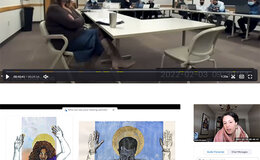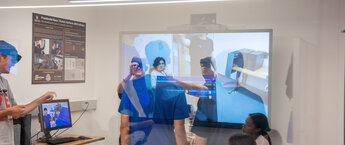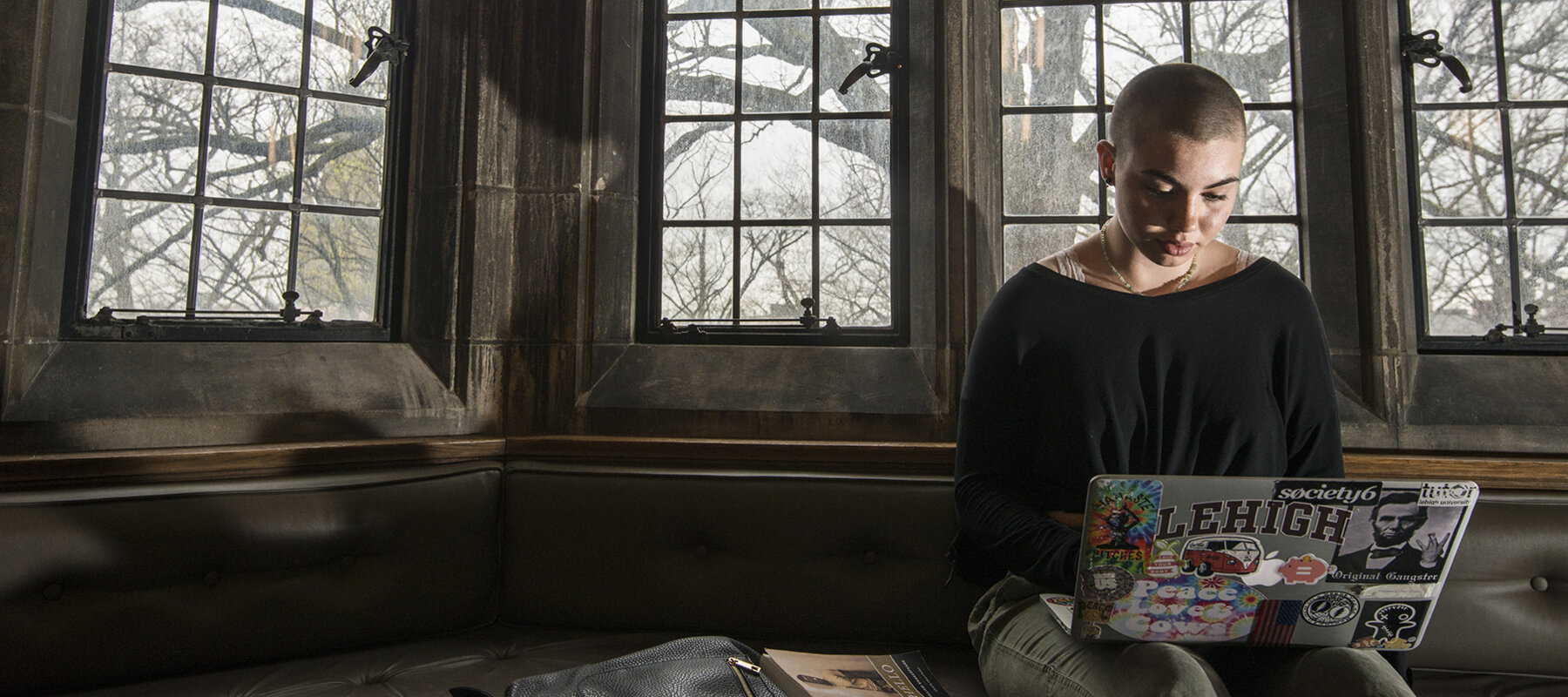While the pandemic may have limited travel over the past two years, Lehigh students have continued to learn and work across borders thanks to new virtual international opportunities. And now as international travel resumes – nearly 300 students will intern or study abroad this summer – virtual programs are an ongoing part of Lehigh’s portfolio of international programs.
Lehigh staff and faculty have incorporated virtual technology in their work in a variety of ways. Here, we look at three approaches to virtual international engagement and then share what we’ve learned so far.

Collaborative Online International Learning (COIL) Comes to English Composition
Collaborative Online International Learning, or COIL, is a pedagogical approach to global learning in which instructors in different countries collaborate virtually to develop and teach a joint thematic unit. COIL did not begin with the pandemic, but the rapid shift to remote learning in March 2020 highlighted the importance of virtual communication and bringing diverse perspectives to large-scale problems.
Staff in Lehigh’s International Center for Academic and Professional English (ICAPE) first tried a COIL collaboration in spring 2020, pairing a section of ENGL 2, a freshman composition course for multilingual speakers of English, with an English club at Miras University in Shymkent, Kazakhstan.
“It started with us because we already had experience in using virtual methods in creative and innovative ways to meet global learning objectives,” says Mark Ouellette, the director of ICAPE.
In spring 2022, Teresa Cusumano, a language specialist in ICAPE, launched another COIL exchange, pairing ENGL 5 with a freshman composition course at Universidad San Francisco de Quito in Quito, Ecuador. The course included synchronous and asynchronous learning, virtual guest speakers and a virtual tour of the Lehigh University Art Galleries.
“We worked on three collaborative multimodal projects in various genres and focused on social justice and environmental issues,” Cusumano says. “It was a very positive experience for me and the students. The students did experience some challenges, but that was the point.”
One of the projects involved making an infographic comparing two aspects of an environmental topic, such as the negative and positive impacts of trophy hunting or the impacts of coronavirus in Ecuador and the United States. This required the groups to organize their ideas and convey them in a clear and concise manner both verbally and visually.
Cusumano says COIL can help both students and faculty increase their cultural awareness and competence. Faculty can also foster new partnerships and learn how to internationalize their curriculum, while students improve their digital literacy and learn how to work in virtual environments. The students in her ENGL 5 class said they especially appreciated learning how to work together effectively.
“The whole culture of work varies in different countries and we need to be aware of that while collaborating,” one student shared. “The way people approach tasks may be different from what we are used to. This always reminds me of the saying: ‘Not better, not worse, just different.’”

Creating a Virtual Site Visit with 360-degree Videos
Global Social Impact Fellows (GSIF) are students from across Lehigh who work with faculty mentors on sustainable development projects in low-income countries, including Kazakhstan, the Philippines and Sierra Leone. Fellows typically work on their projects in the spring and fall semester and travel abroad for faculty-guided fieldwork in the summer.
For the past two years, the Fellows have been using Zoom, WhatsApp and email to work with their partners on the ground. This means that they’re missing some of the local context that’s essential for developing effective solutions. Until, that is, Khanjan Mehta had an idea.
As the vice provost for creative inquiry, Mehta oversees GSIF and is the faculty mentor for several of the projects. The students couldn’t travel, but he still needed to go to Sierra Leone in January to connect with his partners and continue his research. He packed a GoPro camera and took 360-degree videos of the places students would typically visit: the cities of Freetown and Makeni, and the rural village of Lungi Acre. He documented everything from the hotels where the group will stay in the summer to food markets, side streets and private homes. By combining the footage with an Oculus virtual reality headset, Mehta created an immersive experience that lets students see the lives of the people they’re working with.
“I wanted to find a way to quickly ramp up students to understand the context so they can ask the right questions and design things to advance these ventures,” Mehta says. “Students need to realize the things they take for granted based on their own lived experiences and expand their imaginations so they can start questioning their assumptions.”
Mehta says the virtual tour helped the Fellows better understand the local environment, the people who live there and the choices that are available to them. And now they’re better prepared to travel this summer and help develop practical, innovative solutions to expand those choices.
Virtual Semester Internships Expand Access and the Educational Context
Beginning in winter 2021, the Study Abroad Office worked with program provider SIT Study Abroad (SIT) and Kelly Austin, professor of sociology, to offer semester-long, faculty-led virtual international internships. Students now have two options, Virtual Internship in India: Environment, Development, and Sustainability, or Virtual Internship in Kenya: Public Health in the Tropics.
Each program includes a 12-week internship with a local organization and opportunities for intercultural learning and engagement like guest lectures, Q&A sessions with local professionals, and virtual visits to museums and cultural sites. Students also meet with Austin as a group to reflect on their experiences and synthesize what they’re learning. They can complete the internship alongside their regular semester courseload, and there is no additional cost – the internship fee is covered by their semester tuition.
“Through these internships, students get access to real people in Kenya or India while staying on campus,” Austin says. “They may be doing it alongside classes in Health, Medicine and Society or Earth and Environmental Science, and they can make connections and see the issues firsthand directly from community members and organization staff.”
She says the students have developed hard skills, like how to work in Excel or manage data, as well as soft skills like flexibility and the ability to work effectively with people from different cultures and backgrounds. They also gain new confidence and curiosity about regions they may not have previously considered visiting. She says that the team intentionally chose programs that have in-person offerings, so students can eventually travel to India or Kenya to build on their virtual experience.
“The virtual internship may pique their curiosity,” she says. “And if they can go there in another semester, they know the site, have worked with the partners and picked up some language skills. They can hit the ground running and be so much more impactful.”
What We’ve Learned so Far
Virtual opportunities can increase access to international experiences. Because they don’t require travel, virtual experiences can more affordable and easier for busy students to fit into their schedules. And international students or students who are undocumented don’t need to worry about the ramifications of leaving the country.
Technology can bring new opportunities … and challenges. Working with an instructional technologist can help make the best use of available tools. Consider technologies already supported by the university before looking at alternative solutions, and remember that partners may not have the same resources. Technology like high-speed internet and cloud computing isn’t universal.
Virtual programs complement in-person programs; they are not a replacement. A virtual international program can help a student feel more confident about education abroad, especially in destinations that are historically less popular. Educators can develop hybrid programs that incorporate virtual aspects like the 360-degree tour of Sierra Leone to prepare students to make the most of their time in-country. And with intentional planning, virtual and in-person experiences can connect and complement each other.

News & Announcements
 News
News
Virtual International Exchange Community of Practice Supports Teaching Innovation
The collaboration between the Office of International Affairs and the Center for Innovation in Teaching and Learning supports faculty who want to use technology to facilitate virtual international collaborations.
 News
News
Workshop: Globalization through Virtual Exchange and COIL as Strategy
Claudia Tobar, chief innovation officer and professor at Universidad San Francisco de Quito in Ecuador, will present the workshop on September 21.
 News
News
Virtual International Experiences: What We’ve Learned So Far
Virtual programs, which began by necessity during the pandemic, are now an ongoing part of the Lehigh’s portfolio of international programs.
